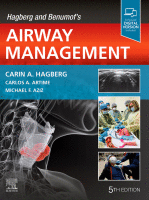Physical Address
304 North Cardinal St.
Dorchester Center, MA 02124

Key Points The opportunity to take still pictures or video-record airway management stands to alter the approach to the medical record. For the novice practitioner or for patients predicted to be difficult to intubate by direct laryngoscopy (DL), video-assisted laryngoscopy…

Key Points The Eschmann Introducer (EI) is best used when the epiglottis can be seen under direct laryngoscopy (DL) (Cormack and Lehane [CL] grade 3 view). The coudé tip can be hooked under the epiglottis, and then the EI is…

Key Points Blind intubation techniques have proven to be effective, safe, and simple techniques, especially in a timely manner during emergency situations where fogging, presence of blood, secretions, and vomitus can create impossible conditions for the direct or indirect laryngoscopic…

Key Points “Resuscitation Sequenced Intubation” for managing critically ill patients and the physiologically difficult airway has become an accepted term describing the process of intubation and transition to positive-pressure ventilation that poses significant risk to the patient in an at-risk…

Key Points There is a wide range of supgraglottic airways (SGAs), and expertise with several devices is necessary to provide optimal airway management to patients in a wide range of settings. Although there is an expanding range of indications for…

Key Points The most important upper airway (UA) soft tissue obstruction site is the soft palate. The one-handed face-mask ventilation (FMV) technique airway maneuver is the chin-lift/head extension (CL/HE) maneuver applied in the sagittal plane (on the occipito-atlanto-axial joint). The…

“Everything has been said before, but since nobody listens, we have to keep going back and beginning all over again.” Andre Gidé, Le traité du Narcisse: Theorie du symbole, 1891 Key Points The early evolution of airway management techniques and…

Key Points Neuromuscular blockade has been shown to improve the ability to face-mask ventilate and perform laryngoscopy. A ketamine induction is likely to preserve spontaneous ventilation; however, apnea has been reported, and airway obstruction is always possible. Succinylcholine, despite its…

Key Points The mainstay technique for increasing the apneic window is through preoxygenation with spontaneous face-mask ventilation and 100% oxygen. More recently, there has been increased emphasis on perioxygenation , which also involves providing oxygenation during the apneic period. Preoxygenation…

Key Points The incidence of pulmonary aspiration in the general surgical population is low, but it is slightly increased among obstetric, pediatric, and trauma patients. It remains the leading cause of death related to airway management. Regurgitation and aspiration can…